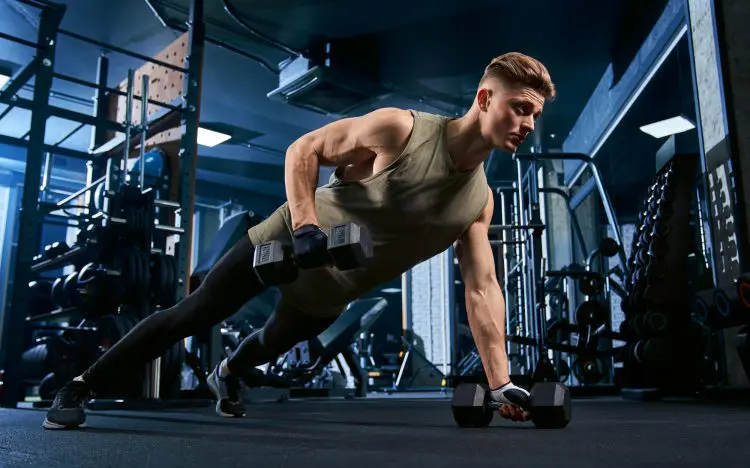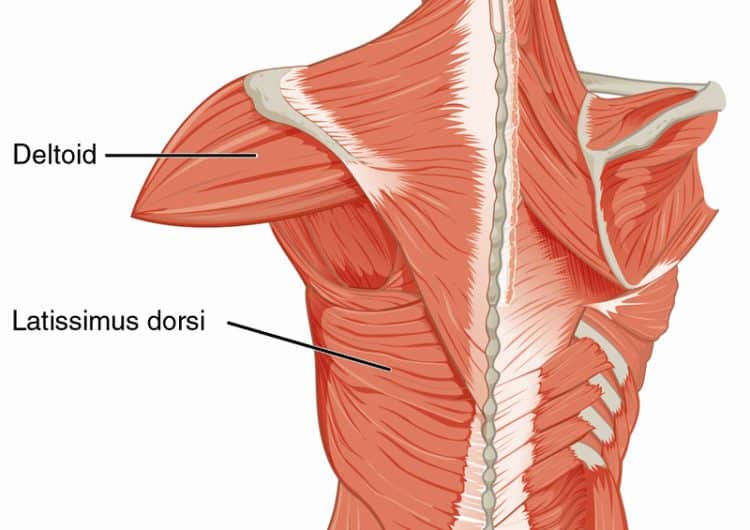If you want to develop your lats fully, you’ve got to do both pulling and rowing exercises. However, many popular pulling exercises like lat pulldowns require a pulley. But don’t worry if you’ve only got a pair of dumbbells. We’ve got you covered.
Dumbbells are great for rowing exercises for the lats. But you cannot do vertical pulling exercises with them. So, in addition to the eight exercises here, we recommend doing pull-ups to build wider lats.
Here we reveal the eight best dumbbell exercises for the lats, along with some pro tips to get the most out of your back workout.
8 Best Dumbbell Exercises for Lats
Here are the eight best Dumbbell Lat Exercises that should be a part of your exercise arsenal:
- Seal Row
- Incline Bench Dumbbell Row
- Bent-Over Dumbbell Row
- Renegade Row
- Single-Arm Dumbbell Row
- Dumbbell Row to Hips
- Dumbbell Pull-Up
- Isometric Hold Dumbbell Row
1. Seal Row
- Target Muscle Group: Latissimus dorsi
- Secondary Muscles: Trapezius, rhomboids, rear deltoids, and biceps
- Type: Hypertrophy
- Mechanics: Compound
- Equipment: Dumbbell
- Difficulty: Beginner
- Best Rep Range:
- Hypertrophy: 8-12
- Strength: 1-5
The seal row is one of the best rowing exercises to isolate the lats. Because you are lying on a bench, you remove the possibility of using momentum, which could rob you of some of the benefits of the movement.
Steps:
- Raise the height of a standard bench by placing 45-pound plates under it (or use a specialized seal row bench). Place a pair of dumbbells under the bench.
- Lie prone on the bench and extend your arms to grab the dumbbells at shoulder width with an overhand pronated grip.
- Press your stomach into the bench, depress your shoulder blade and lift your chest.
- Now pull the dumbbells up to the bench. Squeeze your shoulder blades together at the top and contract your lats.
- Lower under control and repeat.
Pros Tips:
Level Up Your Fitness: Join our 💪 strong community in Fitness Volt Newsletter. Get daily inspiration, expert-backed workouts, nutrition tips, the latest in strength sports, and the support you need to reach your goals. Subscribe for free!
- Use a weight that will allow 12-15 reps on the first set.
- Pyramind down by adding weight and decreasing reps each set until you are doing six reps on your last set.
Benefits of the Seal row:
- Eliminates momentum
- Lower back-friendly
2. Incline Bench Dumbbell Row
- Target Muscle Group: Latissimus dorsi
- Secondary Muscles: Trapezius, rhomboids, rear deltoids, and biceps
- Type: Hypertrophy
- Mechanics: Compound
- Equipment: Dumbbell
- Difficulty: Beginner
- Best Rep Range:
- Hypertrophy: 8-12
- Strength: 1-5
The incline bench dumbbell row is another rowing movement that helps eliminate momentum, making the lats do all the work. The support of the bench also relieves lower back strain.
Steps:
- Set an incline bench to a 45-degree angle. Place a pair of dumbbells on the floor at the head of the bench.
- Lie face down on the bench and plant your feet on the floor. Push your core into the bench as you reach down to grab the dumbbells with a neutral grip (palms facing each other). Alternatively, you could have a training partner hand you the dumbbells.
- Depress your shoulder blades and spread the lats.
- Now pull the dumbbells up to bring them to your ribs level. Squeeze the shoulder blades together at the top and contract your lats.
- Lower under control and repeat.
Pros Tips:
- Concentrate on the stretch and lat contraction with each rep.
- Hold the top contracted position for a second, with the shoulder blades squeezed together, before lowering.
Benefits of the incline bench dumbbell row:
- Works each side individually
- Reduces momentum
- Lower back-friendly
3. Bent-Over Dumbbell Row
- Target Muscle Group: Latissimus dorsi
- Secondary Muscles: Trapezius, rhomboids, rear deltoids, biceps
- Type: Hypertrophy
- Mechanics: Compound
- Equipment: Dumbbell
- Difficulty: Beginner
- Best Rep Range:
- Hypertrophy: 8-12
- Strength: 1-5
The bent-over dumbbell row can help add slabs of mass to your back. Using dumbbells instead of a barbell makes the movement easier on your wrists as you can hold the weights at an angle.
Steps:
- Stand with your feet shoulder-width apart and a pair of dumbbells in your hands. Hinge at the hips to lower your torso to a 30-degree angle with the floor.
- Hang your arms down toward the floor.
- While maintaining a neutral spine, pull the dumbbells to your ribcage.
- Lower and repeat.
Pros Tips:
- Do not use momentum to lift the weight by bucking the hips.
- Make sure your torso remains in the same position throughout the movement.
Benefits of the bent-over dumbbell row:
- A wrist-friendly bent-over barbell row variation
- Allows you to lift heavy
4. Renegade Row
- Target Muscle Group: Latissimus dorsi
- Secondary Muscles: Trapezius, rhomboids, rear deltoids, and biceps
- Type: Hypertrophy
- Mechanics: Compound
- Equipment: Dumbbell
- Difficulty: Beginner
- Best Rep Range:
- Hypertrophy: 8-12
- Strength: 1-5
The renegade row is an awesome lats exercise that also works your core. That’s because you are doing the rowing movement from a high plank position. This movement also brings your stabilizer muscles into action.
Steps:
- Assume a high plank position.
- Grab a dumbbell in each hand with a neutral grip and place them under your shoulders.
- Your arms should be fully extended. Your body will form a diagonal line from your neck to your ankles.
- While maintaining a tight core, row the dumbbell on your right up to your ribcage.
- Lower the dumbbell and repeat on the left side.
- Continue alternating sides to complete the recommended rep count.

Pros Tips:
- Use a 10-15 reps rep range.
- Squeeze the shoulder blades together at the top.
Benefits of the renegade row:
- Lets you work your lats unilaterally
- Recruits the core and stabilizer muscles
5. Single-Arm Dumbbell Row
- Target Muscle Group: Latissimus dorsi
- Secondary Muscles: Trapezius, rhomboids, rear deltoids, and biceps
- Type: Hypertrophy
- Mechanics: Compound
- Equipment: Dumbbell
- Difficulty: Beginner
- Best Rep Range:
- Hypertrophy: 8-12
- Strength: 1-5
The one-arm dumbbell row allows you to train each lat unilaterally. It prevents the stronger side from taking over, which usually happens while using a barbell, resulting in the bar coming up at an angle.
Steps:
- Stand side-on to a flat bench with a dumbbell in your outside hand. Assume a staggered stance with your outside leg extended back.
- Place your closest hand on the bench. Allow the dumbbell to hang at your side, depressing your shoulder blade and stretching the lat.
- Pull the dumbbell up to your ribcage. Squeeze the shoulder blades together in the top position.
- Lower and repeat.
Pros Tips:
Level Up Your Fitness: Join our 💪 strong community in Fitness Volt Newsletter. Get daily inspiration, expert-backed workouts, nutrition tips, the latest in strength sports, and the support you need to reach your goals. Subscribe for free!
- Use a 10-15 rep range.
- Squeeze the shoulder blades together and contract your lats in the top position.
Benefits of the single-arm dumbbell row:
- Works each side unilaterally
- Lower back-friendly
6. Dumbbell Row to Hips
- Target Muscle Group: Latissimus dorsi
- Secondary Muscles: Trapezius, rhomboids, rear deltoids, and biceps
- Type: Hypertrophy
- Mechanics: Compound
- Equipment: Dumbbell
- Difficulty: Beginner
- Best Rep Range:
- Hypertrophy: 8-12
- Strength: 1-5
The dumbbell row to the hip is a one-arm dumbbell row variation that does a better job of following the direction of the lat muscle fibers. Rather than pulling the weight to your ribcage, you bring it up in an arching movement to the hip.
Steps:
- Stand alongside a bench with a dumbbell in your right hand. Place your left hand on the bench for support and step your left leg back in a staggered stance.
- In this position, your torso should be at a 45-degree angle with the floor.
- With the dumbbell hanging directly below your shoulder, row the weight up and back to touch your hip. Be sure to keep your shoulders down and your chest up as you row.
- Hold the contraction for a second.
- Slowly return to the starting position.
- Repeat for required reps before switching sides.
Pro Tip:
- Don’t use a weight that is too heavy. Concentrate on achieving a full stretch and contraction in the lats.
Benefits of the dumbbell row to hips:
- Works each side individually
- Lower back-friendly
- More precisely follows the lat muscle fiber direction
7. Dumbbell Pull-Up
- Target Muscle Group: Latissimus dorsi
- Secondary Muscles: Trapezius, rhomboids, rear deltoids, and biceps
- Type: Hypertrophy
- Mechanics: Compound
- Equipment: Dumbbell, pull-up bar
- Difficulty: Advanced
- Best Rep Range:
- Hypertrophy: 8-12
- Strength: 1-5
Pull-ups are a very good exercise to move the lats from an extended to a contracted position and help build lat width. You can take your lat gains to the next level on this exercise by adding a dumbbell to the mix.
Steps:
- Place a dumbbell on its end directly under a pull-up bar. Stand under the bar and reach up to grab it with a shoulder-width overhand grip.
- Lock your feet under the top plate of the dumbbell.
- Perform a pull-up by pulling your body up toward the bar. Your goal is to touch your chin to the bar.
- Lower under control and repeat.
Pro Tip:
- Depress your shoulders and squeeze your shoulder blades together at the top.
Benefits of the dumbbell pull-up:
- Allows you to overload your lats in the 6-8 rep range
- Works the lats through their full range of motion
8. Isometric Hold Dumbbell Row
- Target Muscle Group: Latissimus dorsi
- Secondary Muscles: Trapezius, rhomboids, rear deltoids, and biceps
- Type: Hypertrophy
- Mechanics: Compound
- Equipment: Dumbbell
- Difficulty: Beginner
- Best Rep Range:
- Hypertrophy: 8-12
- Strength: 1-5
This conventional dumbbell row variation includes a 15-second hold at the top.
Steps:
- Stand with your feet shoulder-width apart and a pair of dumbbells in your hands by your sides.
- Hinge at the hips to lower your torso until it is almost parallel to the floor.
- Row the dumbbells up to your ribcage.
- Hold this position for 15 seconds. Squeeze your shoulder blades together and contract your lats during the hold.
- Lower under control.
- Repeat for recommended reps.
Pros Tips:
- Avoid using momentum to row the weights up.
- Do not round your back.
Benefits of the isometric hold dumbbell row:
- A low-impact exercise
- Can deliver muscle-ripping pumps
Latissimus Dorsi Anatomy
The latissimus dorsi is a large muscle group that covers about half of the back. The lat muscle fibers originate on the lower two-thirds of the spine, the lower ribs, and the iliac crest of the pelvis. All these muscle fibers travel up diagonally to insert just below the head of the humerus (upper arm bone) in the armpit area.

The function of the lats is to pull the upper arm down and in toward the hip, and the arms back behind the body. To simulate both these functions, you should be doing exercises that involve pulling the arms down, such as lat pulldowns and pull-ups, and rowing movements to bring the elbows back beyond the torso, such as the dumbbell exercises to follow.
Frequently Asked Questions
Can you get a complete lat workout only with dumbbells?
No, you cannot get a complete lat workout with just dumbbells. The function of the lats is to pull down and row back. It isn’t possible to do a pulling movement with a dumbbell.
As a result, you need to do exercises like lat pulldowns or pull-ups and rowing exercises with dumbbells that have been detailed above.
What are the advantages of using dumbbells instead of a barbell for working the lats?
You can work your back unilaterally while using dumbbells, which prevents the stronger side from taking over and ensures even muscle and strength development. Dumbbells also allow you to use a neutral grip, where your palms face each other.
How many sets should I do to work my lats?
You should do 12-14 sets in a back workout to work your lats optimally. These sets should be evenly divided between rowing exercises, such as those described above, and pulling exercises like lat pulldowns and pull-ups.
Wrapping Up
You don’t have to rely on a cable machine for an optimal lat workout. You can develop a thick and wide back with a pair of dumbbells, a bench, and a pull-up bar.
Select a couple of exercises mentioned above, add a couple of pull-down exercises (like the lat pull-down and straight arm lat pull-down), and pull-ups for a total of a 12-14 set back workout, and you will be well on your way to building a barn door back.








